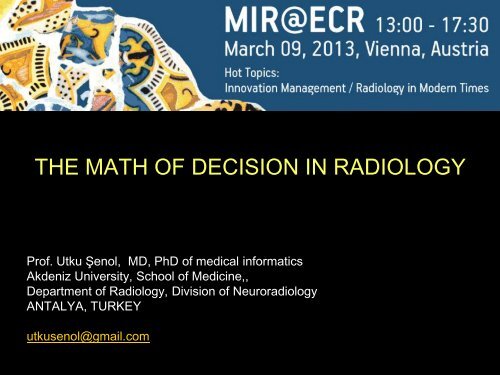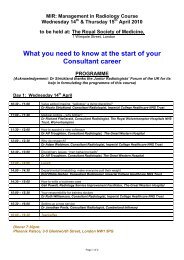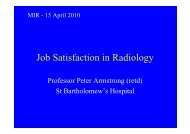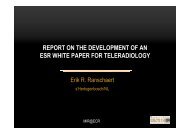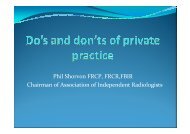The math of decision in Radiology - MIR
The math of decision in Radiology - MIR
The math of decision in Radiology - MIR
You also want an ePaper? Increase the reach of your titles
YUMPU automatically turns print PDFs into web optimized ePapers that Google loves.
THE MATH OF DECISION IN RADIOLOGY<br />
Pr<strong>of</strong>. Utku Şenol, MD, PhD <strong>of</strong> medical <strong>in</strong>formatics<br />
Akdeniz University, School <strong>of</strong> Medic<strong>in</strong>e,,<br />
Department <strong>of</strong> <strong>Radiology</strong>, Division <strong>of</strong> Neuroradiology<br />
ANTALYA, TURKEY<br />
utkusenol@gmail.com
Contents<br />
• Decision mak<strong>in</strong>g <strong>in</strong> radiology<br />
• Test characteristics<br />
• Likelihood ratios<br />
• Predictive values<br />
• Calculat<strong>in</strong>g post-test probability<br />
• Bayesian approach<br />
• Probability revision<br />
• Nomograms, Probability graphs
Question 1<br />
A lymphadenopathy <strong>in</strong> mediast<strong>in</strong>um was reported<br />
Sensitivity 90%<br />
Specificity 80%<br />
What is the actual probability <strong>of</strong> the lymphadenopathy?<br />
A) 2-3%<br />
B) 20-25%<br />
C) 50-60%<br />
D) 80-90%<br />
E) Can not be calculated
Question 2<br />
• A Breast cancer screen<strong>in</strong>g program<br />
• Prevalence <strong>of</strong> the Breast Ca is 0.1%<br />
• A positive mammogram was reported.<br />
sensitivity 95%<br />
specificity 95%<br />
What is the actual probability <strong>of</strong> the patient hav<strong>in</strong>g a cancer?<br />
A) 2%<br />
B) 10-20%<br />
C) 50-60%<br />
D) 90-95%<br />
E) Can not be calculated
When Do Radiologists Make Decision ?<br />
• While<br />
– Diagnos<strong>in</strong>g<br />
– Exclud<strong>in</strong>g disease<br />
– Giv<strong>in</strong>g probability for a certa<strong>in</strong> disease<br />
– Choos<strong>in</strong>g the proper exam<br />
– Plann<strong>in</strong>g a survey program<br />
– …
How Do Radiologists Make Decision?<br />
Do <strong>The</strong>y Use Probability or Math?
• Virtually always<br />
• Often<br />
• Not <strong>of</strong>ten<br />
• Virtually never<br />
AJR 174:2000 letter from Kliewer
AJR 174:2000 letter from Kliewer
Sir William Osler<br />
1849 -1919<br />
“Medic<strong>in</strong>e is a science <strong>of</strong><br />
uncerta<strong>in</strong>ty and an art<br />
<strong>of</strong> probability”
Do not treat<br />
Further tests<br />
or follow-up<br />
Treat<br />
0%<br />
Very unlikely<br />
to have disease<br />
25%<br />
Probably doesn’t<br />
have disease<br />
50%<br />
Don’t know<br />
75%<br />
Probably does<br />
have<br />
100 %<br />
Very likely<br />
to have disease
Probability <strong>in</strong> Orders<br />
• Thunderclap headache<br />
• Lower quadrant pa<strong>in</strong>, leukocytosis,<br />
womit<strong>in</strong>g, ribaund<br />
• Lung Ca, recent vertigo, Rull out bra<strong>in</strong><br />
metastasis<br />
• 35 year age woman, pa<strong>in</strong> and visual loss <strong>in</strong><br />
right eye and hemiparesis
Probability <strong>in</strong> Reports<br />
• Hemorrhagic density with sulcal pattern<br />
• Well circumscribed lytic lesion with a<br />
sclerotic rim <strong>in</strong> distal femur<br />
• An ill def<strong>in</strong>ed solitary nodule <strong>in</strong> right apex
Subjective probability <strong>of</strong> estimates are not statistical<br />
and are highly prone to error!!<br />
Those errors may be as;<br />
• Pesudodiagnosticity<br />
• Premature diagnosis<br />
• Errors Caused by Heuristics<br />
– Availability<br />
– Representativeness<br />
– Anchor<strong>in</strong>g and adjustment<br />
– Value-<strong>in</strong>duced bias<br />
– Affect heuristics<br />
– …..
How do we use tests to def<strong>in</strong>e<br />
probability?
Diagnostic tests are not perfect.<br />
False positive and false negative results cannot be elim<strong>in</strong>ated…<br />
Sorry, you can not have baby<br />
But, We had<br />
Tests say<br />
you can’t.<br />
Give<br />
them to<br />
me…
Sensitivity and Specificity<br />
Sensitivity (TPR) = a/a+c<br />
Specificity (TNR) = d/b+d<br />
Test +<br />
Disease<br />
+<br />
a<br />
Disease<br />
-<br />
b<br />
Total<br />
a+b<br />
TP<br />
FP<br />
Test -<br />
c<br />
d<br />
c+d<br />
FN<br />
TN<br />
Total<br />
a+c<br />
b+d<br />
a+b+c+d<br />
TP+FN<br />
TN+FP
Which Test is the Strongest?<br />
Test Sensitivity Specificity<br />
A 80% 75%<br />
B 60% 85%<br />
C 70% 80%<br />
D 78% 78%
Likelihood Ratios<br />
A unique value generated by us<strong>in</strong>g both<br />
specificity and sensitivity<br />
A perfect <strong>in</strong>dicator for def<strong>in</strong><strong>in</strong>g strength <strong>of</strong> tests
Positive Likelihood Ratio<br />
LR+ = sensitivity/(1-specificity)<br />
Sensitivity = 90%<br />
Specificity = 95%<br />
LR+ = .90/.05 = 18 =<br />
<strong>The</strong> probability <strong>of</strong> a positive result <strong>in</strong> a patient with disease<br />
<strong>The</strong> probability <strong>of</strong> a positive result <strong>in</strong> a patient without disease
Positive Likelihood Ratio<br />
• 10 or<br />
strong<br />
• 5-10<br />
medium<br />
• 2-5<br />
weak<br />
• 2 or<br />
too weak
Test Sensitivity Specificity<br />
A 80% 75%<br />
B %65 %85<br />
C %70 %80<br />
D %78 %78
Test Sensitivity Specificity LR+<br />
A 80% 75%<br />
3.2<br />
B %65 %85<br />
4.3<br />
C %70 %80<br />
3.5<br />
D %78 %78<br />
3.54
Test Sensitivity Specificity LR+ LR-<br />
A 80% 75%<br />
3.2 0.26<br />
B %65 %85<br />
4.3 0.41<br />
C %70 %80<br />
3.5 0.37<br />
D %78 %78<br />
3.54 0.28
Negative Likelihood Ratio<br />
LR- = (1- sensitivity) / specificity<br />
Sensitivity = %90<br />
Specificity = %95<br />
LR- = 0.10 / 0.95 = 0.105
Negative Likelihood Ratio<br />
• 0.1 ve<br />
strong<br />
• 0.1 - 0.2<br />
medium<br />
• 0.2 - 0.5<br />
weak<br />
• 0.5 ve<br />
too weak
Likelihood Ratios<br />
Strong<br />
medium<br />
medium<br />
Strong
LR helps to predict the post-test<br />
probability
What about Predictive Values?<br />
Positive predictive value<br />
• Probability <strong>of</strong><br />
hav<strong>in</strong>g disease<br />
when the test is<br />
positive<br />
Negative predictive value<br />
• Probability <strong>of</strong> not<br />
hav<strong>in</strong>g disease<br />
when the test is<br />
negative
Disease<br />
Disease<br />
Total<br />
+<br />
-<br />
Test +<br />
a<br />
b<br />
a+b<br />
TP<br />
FP<br />
TP+FP<br />
Test -<br />
c<br />
d<br />
c+d<br />
FN<br />
TN<br />
FN+TN<br />
Total<br />
a+c<br />
b+d<br />
a+b+c+d<br />
TP+FN<br />
TN+FP<br />
Positive Predictive Value: a/a+b<br />
Negative Predictive Value: d/c+d<br />
Sensitivity:<br />
Specificity:<br />
a/a+c<br />
d/b+d
Test Characteristics<br />
(sensitivity, specificity)<br />
Predictive values<br />
• May be<br />
generalized to<br />
different<br />
populations<br />
• Can not be<br />
generalized to<br />
other groups<br />
Unique for a<br />
specific study<br />
group
D+ D - Total<br />
T + 63 18 81<br />
T - 37 82 119<br />
Sensitivity: 63%<br />
Specificity: 82%<br />
PPV: 77%<br />
Toplam 100 100 200<br />
D + D - Total<br />
T + 63 162 225<br />
T - 37 738 775<br />
Sensitivity: 63%<br />
Specificity: 82%<br />
PPV: 28%<br />
Total 100 900 1000
How do we calculate the<br />
probability after the test?
Probability revision<br />
<strong>The</strong> probability after a positive result<br />
Pre test probability<br />
<strong>The</strong> probability after a negative result
Post-test probability can be<br />
calculated only if there is a pre-test<br />
probability
Post-test probability calculation<br />
methods<br />
• Bayes formulation<br />
• Decision tree<br />
• Cont<strong>in</strong>gency table revision<br />
• Nomogram<br />
• Conditional probability graphs<br />
Post-test Odds = Pre-test Odds x LR
Post-test Odds = Pre-test Odds x LR<br />
Post-test probability<br />
Pre-test probability<br />
1- post-test probability = 1- pre-test probability<br />
x LR
Nomogram<br />
Pre-t Prob<br />
LR<br />
Post-t Prob.
Post-test probability<br />
Probability graph:<br />
1<br />
.9<br />
Test +<br />
.8<br />
.7<br />
.6<br />
.5<br />
.4<br />
.3<br />
.2<br />
.1<br />
Test -<br />
0 .1 .2 .3 .4<br />
Pre-test probability<br />
.5 .6 .7 .8 .9 1
Question 1<br />
LR+=4.5<br />
Pre-test probability= ???<br />
A CT report <strong>in</strong>dicates a lymphadenopathy <strong>in</strong> mediast<strong>in</strong>um.<br />
Sensitivity 90%<br />
Specificity 80%<br />
What is really the probability <strong>of</strong> the lymphadenopathy?<br />
A) 2-3%<br />
B) 20-25%<br />
C) 50-60%<br />
D) 80-90%<br />
E) Can not be calculated
Question 2<br />
LR+=19<br />
Pre-test probability=1/1000<br />
• Mammography screen<strong>in</strong>g program<br />
• Prevalence <strong>of</strong> the Breast Ca is 0.1%<br />
• A positive mammogram was reported.<br />
sensitivity 95%<br />
specificity 95%<br />
What is really the probability <strong>of</strong> the patient hav<strong>in</strong>g a cancer?<br />
A) 2%<br />
B) 10-20%<br />
C) 50-60%<br />
D) 90-95%<br />
E) Can not be calculated<br />
%1.93
Summary - I<br />
• Radiologists frequently deal with probabilities<br />
while mak<strong>in</strong>g <strong>decision</strong><br />
• To be familiar with the <strong>math</strong> <strong>of</strong> the <strong>decision</strong><br />
mak<strong>in</strong>g process is helpful
Summary - II<br />
• Likelihood ratios are used to def<strong>in</strong>e;<br />
– strength <strong>of</strong> test<br />
– post test probability
Summary - III<br />
• Likelihood ratios are calculated by sensitivity<br />
and specificity<br />
LR + = sensitivity/(1-specificity)<br />
LR - = (1-sensitivity)/specificity
Summary - IV<br />
• Post test probability can not be calculated without<br />
pre-test probability.<br />
• So, cl<strong>in</strong>ical <strong>in</strong>formation is crucial !!
Conclusion-IV<br />
Post test probability can be calculated based on<br />
Bayes pr<strong>in</strong>ciples:<br />
Post-test Odds = Pre-test Odds X LR


